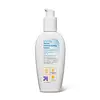What's inside
What's inside
 Key Ingredients
Key Ingredients

 Benefits
Benefits

 Concerns
Concerns

 Ingredients Side-by-side
Ingredients Side-by-side

Butyl Methoxydibenzoylmethane 3%
UV AbsorberHomosalate 12%
Skin ConditioningEthylhexyl Salicylate 5%
UV AbsorberOctocrylene 6%
UV AbsorberIsododecane
EmollientDimethicone Crosspolymer
Emulsion StabilisingPolymethylsilsesquioxane
Dimethicone/Bis-Isobutyl PPG-20 Crosspolymer
EmollientNeopentyl Glycol Diheptanoate
EmollientPolyester-7
Skin ConditioningIsohexadecane
EmollientJojoba Esters
EmollientSilica
AbrasiveButyrospermum Parkii Butter
Skin ConditioningDicaprylyl Carbonate
EmollientTocopheryl Acetate
AntioxidantCaprylic/Capric Triglyceride
MaskingTocopherol
AntioxidantButyl Methoxydibenzoylmethane 3%, Homosalate 12%, Ethylhexyl Salicylate 5%, Octocrylene 6%, Isododecane, Dimethicone Crosspolymer, Polymethylsilsesquioxane, Dimethicone/Bis-Isobutyl PPG-20 Crosspolymer, Neopentyl Glycol Diheptanoate, Polyester-7, Isohexadecane, Jojoba Esters, Silica, Butyrospermum Parkii Butter, Dicaprylyl Carbonate, Tocopheryl Acetate, Caprylic/Capric Triglyceride, Tocopherol
Homosalate 15%
Skin ConditioningOctocrylene 2%
UV AbsorberZinc Oxide 6.3%
Cosmetic ColorantWater
Skin ConditioningNiacinamide
SmoothingGlycerin
HumectantCetearyl Alcohol
EmollientDimethicone
EmollientCetearyl Glucoside
EmulsifyingCeramide NP
Skin ConditioningCeramide AP
Skin ConditioningCeramide EOP
Skin ConditioningSodium Hyaluronate
HumectantAluminum Starch Octenylsuccinate
AbsorbentBoron Nitride
AbsorbentHydroxyethylcellulose
Emulsion StabilisingDisodium EDTA
Cetyl Palmitate
EmollientSorbitan Palmitate
EmulsifyingSorbitan Olivate
EmulsifyingPhenoxyethanol
PreservativeCapryloyl Glycine
CleansingUndecylenoyl Glycine
CleansingTriethoxycaprylylsilane
Sodium Lauroyl Lactylate
EmulsifyingPhytosphingosine
Skin ConditioningCholesterol
EmollientCarbomer
Emulsion StabilisingXanthan Gum
EmulsifyingHomosalate 15%, Octocrylene 2%, Zinc Oxide 6.3%, Water, Niacinamide, Glycerin, Cetearyl Alcohol, Dimethicone, Cetearyl Glucoside, Ceramide NP, Ceramide AP, Ceramide EOP, Sodium Hyaluronate, Aluminum Starch Octenylsuccinate, Boron Nitride, Hydroxyethylcellulose, Disodium EDTA, Cetyl Palmitate, Sorbitan Palmitate, Sorbitan Olivate, Phenoxyethanol, Capryloyl Glycine, Undecylenoyl Glycine, Triethoxycaprylylsilane, Sodium Lauroyl Lactylate, Phytosphingosine, Cholesterol, Carbomer, Xanthan Gum
 Reviews
Reviews

Ingredients Explained
These ingredients are found in both products.
Ingredients higher up in an ingredient list are typically present in a larger amount.
Homosalate is a chemical sunscreen filter that provides protection in the UV-B range (280nm - 320 nm), with a peak protection at 306 nm. It is internationally approved for use in sunscreens.
Homosalate is not photo-stable, meaning it's strength as a UV filter degrades over time with exposure to the sun. Because of this, it's often used in combination with other chemical sunscreen filters as avobenzone (which protects from the UV-A range). Homosalate also helps act as a solvent for harder-to-dissolve UV filters.
(Part of the reason that sunscreens need to be frequently re-applied is due to the photo instability of many chemical sunscreen filters)
Currently, homosalate is approved in concentrations up to 10% in the EU and 15% in the US. The FDA is currently doing further research on the effects of homosalate, and it is possible that these approved concentrations will change in the future.
Learn more about HomosalateOctocrylene protects skin from sun damage. It absorbs UV-B with peak absorption of 304 nm. It is a common sunscreen ingredient and often paired with avobenzone, a UVA filter. This is because octocrylene stabilizes other sunscreen ingredients by protecting them from degradation when exposed to sunlight. Octocrylene is a photostable ingredient and loses about 10% of SPF in 95 minutes.
Octocrylene also acts as an emollient, meaning it helps skin retain moisture and softens skin. It is oil-soluble and hydrophobic, enhancing water-resistant properties in a product.
Those who are using ketoprofen, a topical anti-inflammatory drug, may experience an allergic reaction when using octocrylene. It is best to speak with a healthcare professional about using sunscreens with octocrylene.
The EU allows a maximum of these concentrations:
Learn more about Octocrylene